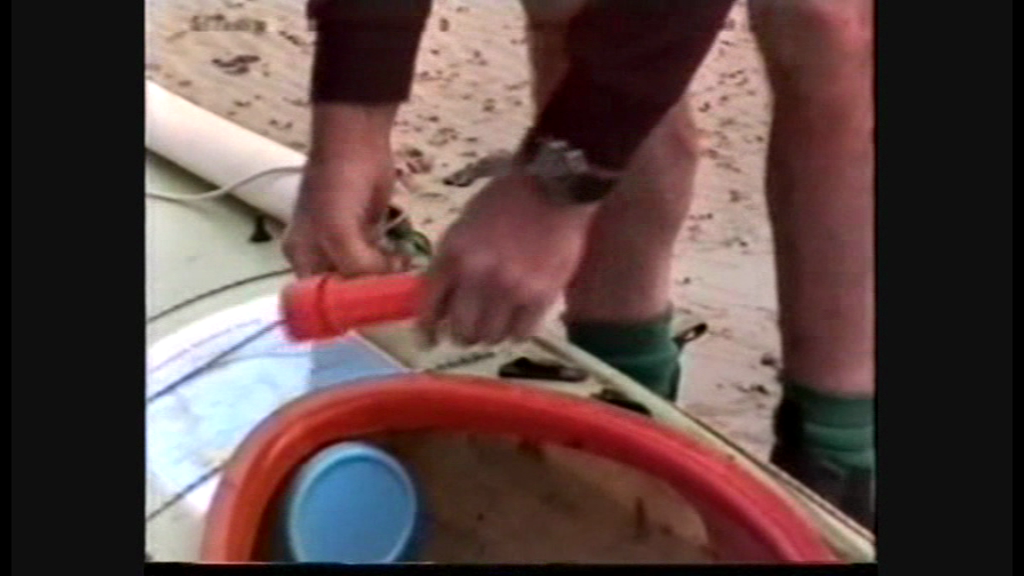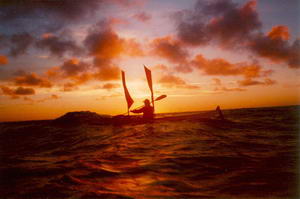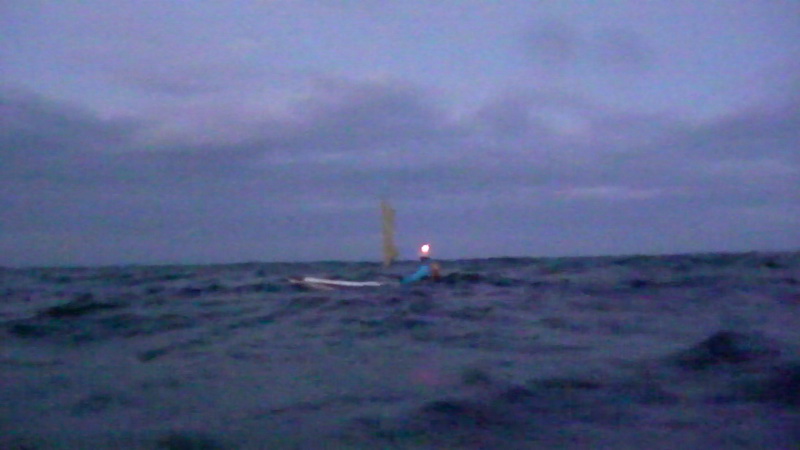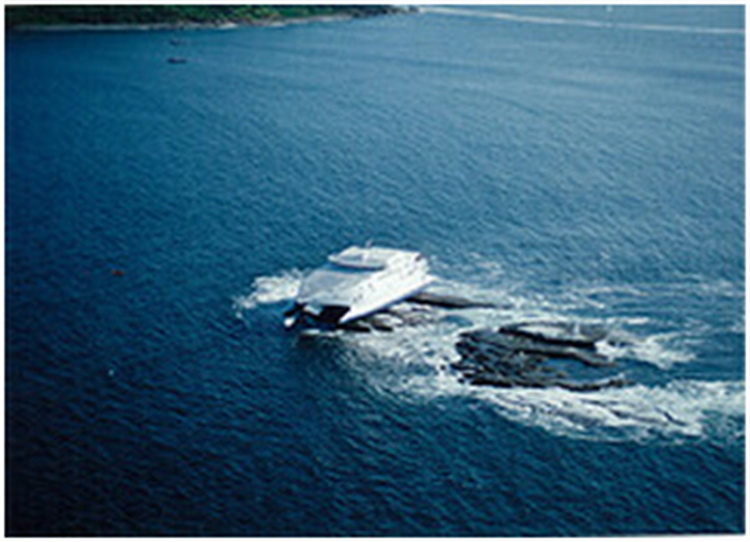Kayaking after dark
I understand that Marine & Safety Tasmania have made various rules for kayakers. At least two of those rules could put my life in danger so if they imagine I am ever going to abide by those rules they are dreaming. I put much more value on my life than to have it endangered by some government department that obviously doesn't have any idea about kayaking – and if they have actually consulted anyone then it must have been retarded 5 year olds.
I started kayaking back in the 70's,
and about 1979 I started to investigate paddling at night. There are
two problems. One:
a party of kayakers need to be able to see where all the other paddlers
are on a very dark night. Two: When
landing after dark you will need a very bright spotlight to be
able to make sure you are landing in a safe place and not on rocks.
In 1979 I paddled off Bellerive Beach with a homemade orange "flasher"
on the deck of my kayak. There were senior sea kayak people on the
beach watching to see how effective it was when I was well off shore -
I can't remember who was there but I'm pretty sure one of them was
Graeme Cooksey who was one of the leading sea kayakers in that time.
The light was very effective. That one had a normal incandescent globe
in it but not too long after that I developed one using LEDs that had a
huge battery life. This design was published in the "Sea Canoeist"
magazine in March 1987. Although these have now been superseded by bike flashers I
recently saw 3 of these old ones still working OK - more than 30 years
after I built them.

These torches are excellent spot lights. I always carry a submersible torch on deck during trips for TWO reasons. One is to try and find a safe landing spot after dark if we have been delayed for some reason - or just doing a night paddle for the fun of it.
The other reason is that if I hear a motor vessel approaching me in the dark I can instantly grab it off the deck and shine it towards the vessel - letting them know I am around. Once I do that I then leave it switched on lying along my deck so that it lights up the forward deck of the kayak till after the vessel has moved past.
This is a quote from a Bass Strait crossing in 1987: (we had just left Killiecrankie on Flinders Island at 8pm to paddle 63 kilometres to Deal Island overnight.) " I took my sail down soon after this, deciding it was more hindrance than help at that stage so just paddled along at the tail of the group following the silhouette of sails and the red lights." (Ian MacDonald)
This is a quote from a Flinders Island trip in 2002,
“At about 6:00pm the wind had turned the windsock on the grass airstrip (Preservation Island) from westerly to norwesterly, there were no more whitecaps to be seen way out in the Strait, and the air felt milder. We decided that this was the moment. The tide was at full. We were underway in ten minutes and soon were enjoying mountainous swells - when they are not breaking the bigger the better! Two sails up in slight wind all the way across. At 8:00pm the sun set as a great ball into the waves. Lingering evening light and peach and mauve colours. Then the half moon began shimmering on to the waves. Just on dark the sea had settled and there were no more swells. We watched Swan Island light and the “loom” of Eddystone Light. We saw the lights from squid boats out further to the east. And an occasional bright light on the distant shore ahead. We could see each other easily in the moonlight. We headed magnetic south by our compasses and were taken just right by the tide to end up at Little Musselroe where we could see the inlet through the beach. Laurie had mentioned that as soon as we lost sight of the lighthouse on Swan Island we would be entering an ‘obscured sector' and must be at Little Musselroe Bay. Tide was at its prime pouring out and while Laurie went in fine I had trouble pulling against it and got out to pull my boat around into the bay, (my second dowsing) got back in and paddled a dozen strokes across to the boat ramp. It was 10:40pm. This had been a glorious day of app. 42k. We put the tent up right there on the grass and next morning talked with Liz Ponting in the end house and signed her paddlers book. I think I may be the oldest woman to paddle across Banks Strait - at 63 - I'm certain I'm the oldest American woman to do it! Now that's fun.” Elli Tappan.
 Elli halfway across Banks Strait as the sun sets.
Elli halfway across Banks Strait as the sun sets.
So paddling at night even in Banks Strait or Bass Strait is not unusual although Marine & Safety Tasmania's retarded consultants may not have ever tried it - even though a 63 year old grandmother thinks it is fun.

On 23 November 2008, at 17:15 the Lady Northcott ran into the stern of Friendship while the former was berthing behind the latter at Circular Quay. No one was on board the Friendship, and no passengers were injured on the Lady Northcott.
On 6 April 2009 the Lady Northcott crashed into rocks after it overshot Taronga Zoo wharf. No one was injured in the accident, and it was blamed on driver error.
On 11 October 2010 at 08:47 the HarbourCat ferry Anne Sergeant ran into the Kirribilli Jeffrey Street Wharf. One passenger was taken to hospital with some other passengers receiving minor injuries.
And we all remember this ferry boat driver - I'm damn glad I was not out on the water that night in any vessel, let alone a kayak.

Friday 16/2/01 – Erith Island to Killiecrankie – 67 km
(Comments by Laurie in red)
We
got up just after 4am and dressed into our paddle gear in the dark. It sounded
windy outside and it was eerie as we paddled off into the darkness at
approximately 5.00 am. Jeff & Jamie hit the lead (in a double) as we headed out the southern end of Murray Passage. Ian stopped
briefly and Phil stopped for Ian and I just slowed down so that I could still
see Jeff & Jamie and back to Phil. Within a couple of minutes Jeff &
Jamie had moved further ahead. As we left Murray Passage, we spread out even
more because Jeff was the only one with a light on his kayak and we were all
disappearing behind the large swells into deep troughs. We could see the light
on Wrights Rock in the distance until it became lighter. (only one kayak had a light – you’re joking. And there is no light
on Wrights Rock – they would have been seeing Craggy Island)
As it became lighter, Phil and I were close together and continued on. We saw Jeff & Jamie further out with Ian behind them. We all grouped up again and had a little discussion about our ‘night’ paddling. We decided that we should all have had adequate lights and whistles. We should also have stayed close enough to communicate if we needed to stop so that we could stay together. (they had been planning this trip for 12 months and now halfway across Bass Strait they decide they should all have had lights???)
(They had met 4 paddlers from NSW on Deal Island.)About
15 minutes after we landed one of the NSW guys turned up by himself. We
expected the others to turn up shortly after but he eventually opened up to
tell us that they split up in the dark early this morning when he had to
duck back to Winter Cove on Deal Island to get his sunglasses. When he paddled
back out, he couldn't find them in the dark so he left without them expecting
to see them when it got light.
(another group
who obviously didn't have lights – what sort of planning did they do? Unbelievable!)
*********************************************************************************************************
Paddling at night is a lot of fun as described above by Elli - a 63 year old Grandmother - after her night paddle across Banks Strait in 2002.Whitemark to Killiecrankie in 1982. Part of my first Bass Strait crossing.
Erith Island to Hogan Island in 1982. Part of my first Bass Strait crossing. I left Erith Island at 2am and arrived on Hogan Island at 7.30am. I left 3 hours later to continue to Wilsons Prom and landed after dark (9.30pm) in Oberon Bay on the west side of the Prom. 111km total.
Wilson's Prom to Killiecrankie in 1982. 105 nautical miles (194km) - 28.5 hours. Part of my second Bass Strait crossing.
Japan in 1982. I had a night paddle in Japan and landed on the island I was looking for about 3 in the morning. I pushed off about 2000 hrs one evening and did a seven hour night stint to the Ship Hostel Island. It was really magic paddling at night. The whole sea phosphoresces at the slightest movement, the bow wave and paddle stroke causing the Longboat to be lit continuously with a ghostly white luminance. Whenever I was close inshore I passed through schools of fish, apparently resting close to the surface and on my approach the whole area in front would be one big boil of white, with individual luminous tracks streaking off in all directions - quite often into the side of the kayak. The first time it happened, I nearly leapt out of the boat myself - after three or four ‘thump’, ‘thump’, ‘thump’ along the bow. The shipping was just as thick after dark as during the day - fishing boats, ferries, and large ocean going freighters, but it was pretty safe. I had a small torch in my life jacket pocket to use on the compass fairly regularly, and to flash at any shipping getting a bit close - but there was always plenty of time to get out of the way once you picked up their red and/or green navigation lights. Very few skippers that night knew I was about, but the radar on the ferries leaves nothing to be desired; twice I was four to five hundred yards away on a parallel course when a searchlight flashed out and picked me up for a few seconds and then went out again - no searching around in my general area looking for me, just ‘zap’ - and I was suddenly dazzled without any warning.
For some time away to the west the flickering lightning of
an approaching electrical storm had been getting closer, and then we were in
the middle of it. Lightning appeared to be zapping into the sea all around the
horizon, with the thunder reverberating like a long drawn out drum roll. I had
hoped that in the lightning flashes we would have been able to see where we
were, but the eye blinked at every flash and we were no wiser. Still, the sea
was still fairly flat and it was exhilarating stuff – the accompanying heavy
rain barely being noticed, even though the Swan Island Lighthouse was blotted
out by it. This display of nature passed on overhead and left us to our own
devices again.
Killiecrankie to Deal Island 1987. We left Killiecrankie about 8pm to paddle to Deal Island. Part of my third Bass Strait crossing. A bit of that report:
Some time before dawn we heard the waves breaking upon, then later saw
Wrights Rock, a very bad sign for although we were on course it meant we
were only two-thirds of the way after nine hours paddling. At about the
same time Deal Island disappeared into mist and cloud. There was nothing
to do but continue on the compass bearing and hope the island appeared
before we passed it. A few hours after dawn a dark image arose amongst
the clouds in the distance in front, our objective at last but still hours
away. Everyone was tiring but no point stopping out here, those last few
hours were painfully slow. As we approached Murray Pass between Deal Island
and Dover & Erith Islands the sea was very confused, no one wanted
to fall out in this lumpy stuff at this stage. To make matters worse we
were going against the tide in the pass so had to keep close to the cliffs
to avoid the full effect.
South Cape Rivulet to Recherche Bay 2007.
Elli and I left South Cape Rivulet at 5.25pm to paddle to Cockle Creek,
arriving at 10pm. A repeat of part of that report: “We watched gannets in their incredible dives and were
surrounded by
hundreds of circling mutton birds after we rounded Whale
Head. The
last two hours of the trip were in darkness and each of us had a red
flashing
bike light attached to our deck. That was all I could see of Laurie.
Bruny
Island light and then Actaeon light were good to focus on.
By the time we could see the navigation light on Fishers Point
(the
entrance to Recherche Bay) the full moon was giving plenty of light
despite
the cloud cover and at times would break through enough to make a
gorgeous
moon path glimmering right to my boat. There were dots of
phosphorescence
as well. I absolutely love night paddling at sea. The headwind was now
behind us and we even sailed for a while in Recherche Bay.
We landed at Cockle Creek at 10:00pm, changed into dry
clothes, opened the boot and threw everything in, had the boats on and lashed
and were on our way home, getting there at 1:30am Saturday. Showers and some
food. And I decided that after seven hours in the car, three hours hiking and
five hours paddling all in one day, 68 isn't really old at all! It's just
normal life with Laurie Ford.”
Erith Island to Killiecrankie 2016. Sue and I left Erith Island at 5am. Part of my 5th Bass Strait crossing.
Preservation Island to Clarke Island 2016. Sue and I left Preservation Island at 4.50am. Part of my 5th Bass Strait crossing.
Laurie Ford. Senior Sea Kayak Instructor.